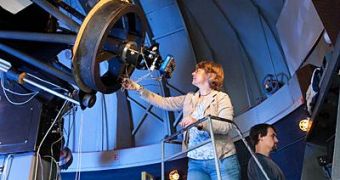The WET (Whole Earth Telescope) instrument is a global network of observatories, which includes others at various locations worldwide. The ample disposition of the array allows it to keep a specific object under continuous surveillance, for instance, which is precisely what the network is now doing with a “cooling star.” The body's life span is nearing its end, and so, by observing it, scientists hope to find the answers to a number of questions related to our planet, as well as to other mysteries in the Universe and our own solar system.
The star in question, designated as WDJ1524-0030, is a white dwarf located in the southern constellation of Ophiuchus. At this point, it's losing the intensity of its brightness fairly quickly, having already spent most of its primary fuel. From May 15th to June 11th, it will remain under constant WET observation. The network of telescopes is coordinated from the University of Delaware, and was formed as a scientific collaboration in 1986. A number of observatories from the US, Australia, China, New Zealand and in Asia and Europe participate in this initiative as well.
“A white dwarf is the size of the Earth and as dense as the sun. This star pulsates or quakes as waves of energy travel through it – its outer surface sloshes from side to side, like waves on the ocean,” Judi Provencial, who is an assistant professor of physics and astronomy at the University of Delaware, and also the director of the Delaware Asteroseismic Research Center (DARC), explains. “What is of interest to scientists is the shape of the pulses. From them, we can measure how the atmosphere is moving around in these pulsating stars and figure out what's going on inside them. This one is really sloshing around.”
Asteroseismology, the science of star quakes, is one of the few observation methods that can be employed to study the age, temperature and composition of a star, using only its brightness and oscillation periods as a reference point. However, of the thousands of white dwarfs that exist in the Milky Way, only about a third is still bright enough to be peered at using this methodology. Also, about 20 percent of the stars in the entire Universe have an atmosphere made up of helium, rather than the “conventional” hydrogen. The goal of the current research is to determine whether WDJ1524-0030 has a hydrogen or an oxygen core.
“We don't understand the weather on Earth, the transport of energy. We don't understand convection at all. Hopefully, this field of research, which is still very new, will help every aspect of astronomy,” Provencial says, adding that astroseismics could also be used to analyze our own Sun, as well as the planet Earth itself.
She has also spoken about the challenges such a study implied before the emergence of the Internet. “In South Africa, we had to call the international operator, who could only get out to the telescope by a hand-cranked phone and you could hear that in the background. The Internet has taken some of the fun out of that, but France still likes to be called every day of the observing run. And at Peak-Turskol in Russia, the astronomers say they have several cats that like to participate.”

 14 DAY TRIAL //
14 DAY TRIAL //